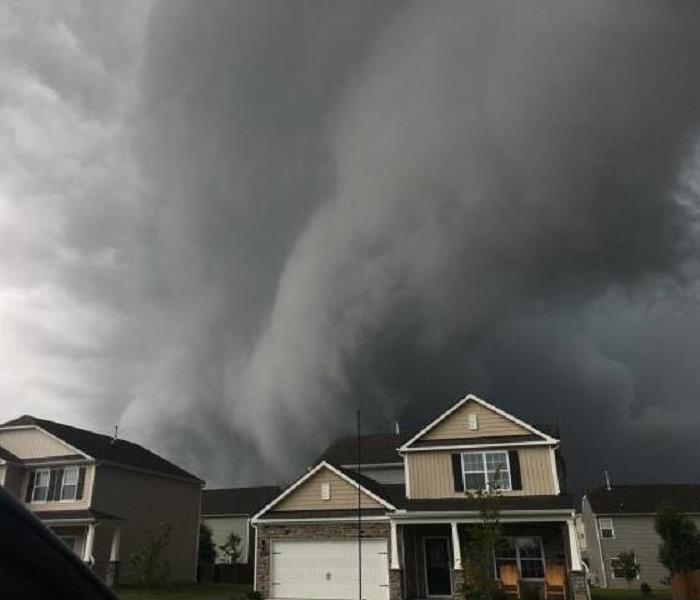What to Do After Storm Damage, Repairs, Tips
7/1/2021 (Permalink)
Knowing the right steps to take after storm damage can go a long way toward protecting you and your family, as well as your property and finances, from risks of further loss. As challenging as storms can be, learning the steps to take before a storm comes through and turns your life upside down will arm you with the knowledge you need to stay prepared. Here are some tips from the restoration and cleanup specialists at SERVPRO of Columbia & Suwannee Counties.
Five Things to Do After Storm Damage
You can mitigate some of the damage caused by a storm by following this checklist:
1. Check your home for damage.
While not all storm damage will be apparent immediately after the storm has passed, checking your home's condition will give you a clearer picture of the extent of the damage left by the storm.
SERVPRO of Columbia & Suwannee's experts provide a word of caution to take all the necessary safety precautions when checking your home since unexpected damage may cause injuries. Watch out for loose or exposed ceiling tiles or floorboards, broken electrical lines, and slippery floors. Fortunately, some safety tips can help:
- Avoid standing water
- Avoid checking for storm damage in the dark.
- Watch out for exposed nails, window damage, collapsed walls and roofing materials, and broken glass
- Switch off the electricity and shut off the main gas line before entering a damaged home
2. Assess the potential damage
During a storm, some areas in a home are more susceptible to damage than others. One site that is often vulnerable is the roof. Common signs of roof damage include:
- Split seams
- Dented, missing, or broken shingles
- Holes in the roof
- Leaks in the ceiling or roof
Other areas that are susceptible to storm damage include doors and windows. Inspect all windows for damaged frames, broken panes, cracks, and holes. Remember to board up any broken windows.
Also, assess your home's exterior, looking for damage such as dents, holes, cracks, and chipping to any brickwork, paint, or siding. The storm could have also damaged outdoor appliances such as air conditioning units.
Taking all the necessary precaution, be sure to remove debris from the gutters and roof, and then check that the downspouts are intact and unobstructed so they can continue diverting water away from your home. Remember to check for mold, which is common after flood damage.
3. Get in touch with your insurance carrier.
Document the damage and loss that has been caused by the storm, taking photos before removing or moving any objects or debris. Remember to document any additional costs incurred due to the loss, such as hotel receipts or other temporary living costs.
Once all this information is together, contact the insurance provider to determine whether your insurance plan covers the damage caused. Likewise, inquire about the steps to take to make a claim.
4. Attend only to the damage you are capable of handling.
In some cases, the storm might not have caused extensive damage, and you may be able to restore what little damage exists with a few repairs before seeking professional repair services. Prompt repairs can go a long way toward limiting the damage.
If that's the case, you should begin with what you can fix yourself, taking care not to cause additional damage. For example, if wind and water are getting into your home through a broken window, board it up as soon as possible. However, if you're not confident in your repair skills, it's best to get in touch with a company that can offer emergency repair services.
5. Choose the right contractor.
The next step is to hire a professional and trustworthy cleaning and restoration service company to restore your home to its former glory. Choosing a contractor that will promptly attend to your home's restoration, take care of water damage, and immediately mitigate the presence of potential mold is critical.
It's essential to ensure that your house is once again a habitable, healthy living environment. That will likely require water cleanup (flood cleanup) and mold removal by a specialized commercial cleaning service.
Getting Back to Normal
While storms can wreak catastrophic damages upon a home or commercial building, promptly addressing the storm damage—first, to make emergency patches and then to take care of longer-term restoration—will go a long way in getting your home or business back to normal.
Why SERVPRO?
SERVPRO is a leading storm damage restoration company that has served Fort Worth for upwards of 50 years. They can handle all aspects of the restoration process, from water removal to debris cleanup.
For more information about storm damage cleanup and restoration, contact SERVPRO of Suwannee Counties.




 24/7 Emergency Service
24/7 Emergency Service
